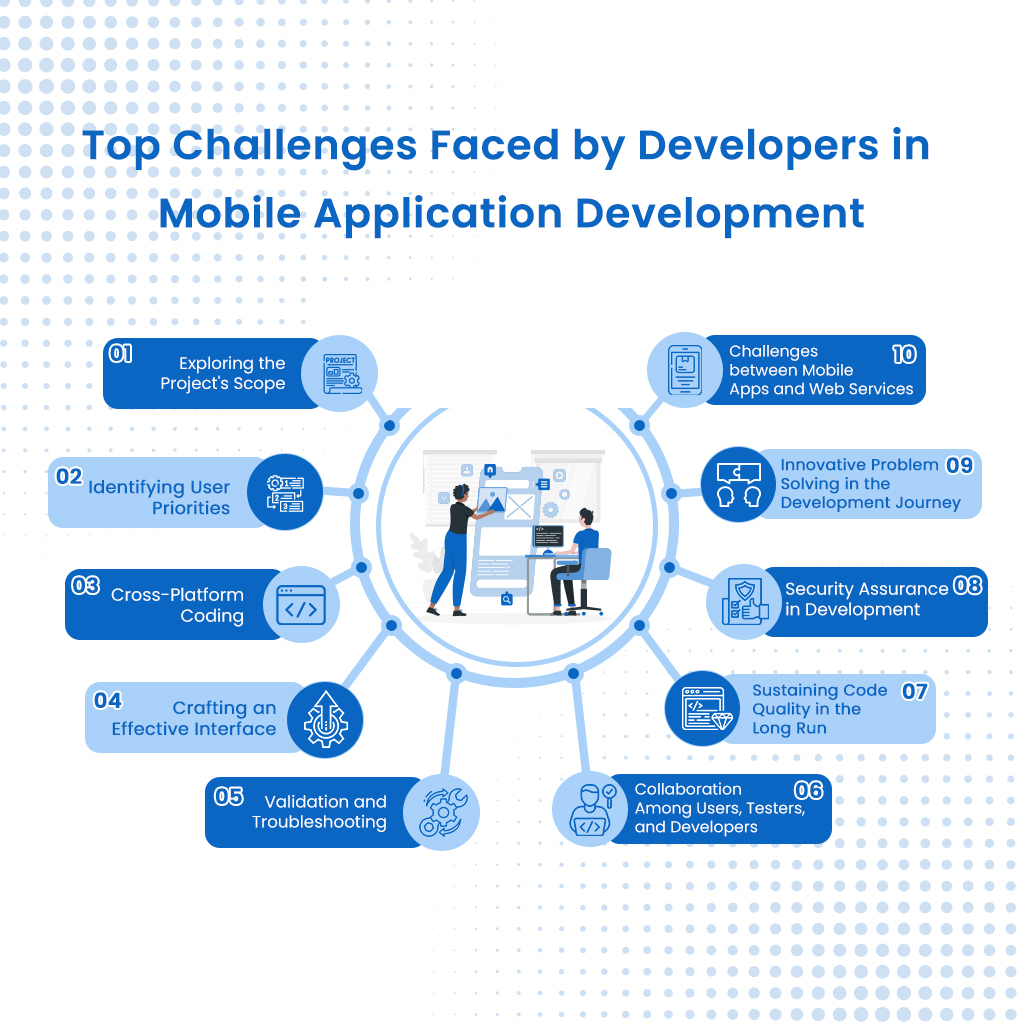Top Challenges Faced by Developers in Mobile Application Development

Exploring the Mobile App Development Challenges for Your Next Project
In today's modern world, we cannot underestimate the importance of mobile apps. The development of Android and iOS has increased rapidly due to which mobile applications have become a magic in our daily life. In the business landscape, crafting high-performance, secure, and user-friendly apps has become highly lucrative.
Yet, Mobile App Developers Encounter Significant Hurdles
Despite the increasing demand for mobile apps, developers face many challenges that demand solutions. These challenges range from grappling with coding complexities due to varying screen sizes to adapting to ever-changing device capabilities and connectivity options.
Addressing these challenges can determine whether your mobile app enjoys success or swiftly vanishes from app stores shortly after its launch. What are the paramount issues to tackle for a successful app launch? What considerations should guide you on your mobile app development journey? Let's delve into this further.

1. Delving into Project Scope
Did you know that 56% of app users uninstall apps within a week of installation? This low retention rate presents a significant problem for the mobile app market, especially given the many alternative apps available. Therefore, before embarking on your app development journey, comprehensive research is imperative to avoid squandering your time, resources, and efforts on creating an app with insufficient demand or one that users swiftly discard. Constructing a list of your app's specifications can streamline your search for a mobile app development partner.
What to focus on:
- Ascertain the demand for your app concept and identify your target audience.
- Determine the ideal code base and business model for your app.
- Contemplate how users will interact with and utilize your app.
- Define the objectives you aim to achieve with your new app.
- Specify the features you intend to incorporate into the mobile development process.
- Assess your app's compatibility across various mobile devices.
- Set a budget for the mobile app development process.
- Formulate a strategy for marketing your software post-launch.
Though it may appear as a daunting list, trust that this meticulous groundwork will not only assist in deciding whether to proceed with your mobile app development but also facilitate more effective communication with your developers.
2. Identifying User Priorities
A common problem in the mobile app development process is failing to understand the desires and preferences of your app's users. Even if you create incredible software and release it on the App Store, it may still be silenced. Few downloads transpire, and those who install the app swiftly uninstall it. This is where thorough research comes to the rescue. By considering what users might need from the app and how they will use it, you can tailor the app to meet their demands effectively.
3.Cross-Platform Coding
Choosing between native and cross-platform coding approaches necessitates a critical decision. Native apps offer better performance, better stability, and full support for built-in functions like the camera. On the other hand, cross-platform apps are more accessible to develop and can reach a wider audience. When deciding the best approach to your mobile app development, consider the platform preferences of your target audience.
Suppose most prospective users favor Android or iOS. In that case, it's advisable to develop for one platform initially and later extend support to the other. However, if your target audience spans both platforms or intends to reach both simultaneously, carefully weigh the pros and cons of native programming against Flutter cross-platform app development.
This decision is pivotal as each option necessitates distinct expertise. Native applications require developers proficient in programming languages such as Java or Swift. In contrast, cross-platform programming experts must be well-versed in Android and iOS cross-platform coding nuances. Thus, it is extremely important to select appropriate programming languages and development frameworks at this time.
4. Crafting an Effective Interface
Consider today's most popular apps; they often share a common trait—a simple and user-friendly interface. The design and usability of an app leave a lasting impression on users. An intuitive layout enables users to easily find and navigate the app's features, increasing engagement.
In contrast, some companies and developers choose a different strategy, and try to pack as many functions as possible into their app to make it an "all-in-one" solution. Sadly, this often results in a disorganized and dull interface that frustrates users, making it challenging for them to find what they need.
So, how can you create an effective app interface? Start by researching similar apps and discerning what works well and what can be improved. Furnishing developers accurate information about your intended app design will facilitate realizing your vision.
5. Validation and Troubleshooting
Did you know that correcting errors after development can be up to 100 times more expensive than fixing them beforehand? This is not an exaggeration. Dealing with issues after the project's completion is time-consuming, mainly if the flaw affects critical functionality.
Moreover, releasing an app with a significant problem that leads to frequent crashes or malfunctions can result in a barrage of negative customer feedback. Even if you promptly resolve the issues, rebuilding users' trust can be a formidable challenge, and their adverse reviews may dissuade others from using your app.
To circumvent such predicaments, diligently test and debug your mobile app before its release. Scrutinise its core features, performance, compatibility, speed, usability, security, and ability to handle high usage. The more time invested in testing the app under various conditions, the higher the likelihood of uncovering issues or errors.
6. Collaboration Among Users, Testers, and Developers
During mobile app development, whether you choose to build it in-house, collaborate with an independent app developer, or engage a professional app development company, it is essential that everyone involved is aware of the essential functionality and design of the app. Understand. Otherwise, upon completion you may find that the app fails to meet your expectations or deviates significantly from the original design.
Minor tweaks pose a problem. Still, if substantial adjustments are needed, it can be time-consuming and may necessitate additional funding for further development. To avert such misunderstandings, meticulously elucidate your ideas and expectations to the development team, potentially employing flowcharts or sketches to enhance communication.
Additionally, it is important to solicit feedback from potential users. By releasing a functional beta test or conducting manual testing of your app's Minimum Viable Product (MVP), you can gather valuable insights on enhancing user-friendliness, thus increasing the chances of a successful app launch. Feel free to involve early adopters in testing the app on multiple platforms to benefit from their feedback.
7. Sustaining Code Quality in the Long Term
As you introduce new features or updates to your app from time to time, the amount of code within it increases. Maintaining clean and error-free code can be challenging, yet leaving the code in its current state is not an option. The performance, security, and compatibility of your application depend on the quality of its underlying code.
Following coding standards is a proven way to ensure high-quality code in your app. These standards promote consistency and readability by providing uniform coding styles to all developers. It is advisable to check the code for errors as you write it.
Developing clean and well-organized code diminishes the risk of issues when implementing future changes to your app. It also facilitates quick app maintenance, allowing developers to quickly address unexpected glitches.
8. Security Assurance in Development
Enhancing the security of your app necessitates implementing various methods, including:
- Encrypting user information.
- Encouraging users to use two-factor authentication.
- Performing a thorough check of any third-party modules used in your app.
- Securing data transmission.
It is also essential to regularly test your app for security flaws and vulnerabilities. Since cyber thieves are constantly developing new attack methods, it is important to keep your app's security features up to date to prevent exploitation of older components and maintain their integrity.
9. Innovative Problem Solving in the Development Journey
No matter how well you plan your app project, you will need help. Complex projects are more likely to deviate from the original plan. Unexpected technological challenges, for example, could require adjustments in scope or the addition of extra team members. The planned approach to adding a new feature may fail at times.
When difficulties happen, remaining calm and working with your developers to discover solutions is critical. First, rather than focusing on the symptoms, determine the fundamental cause of the problem. Then, collect information about prospective solutions. Brainstorm ideas with your team and contribute to the best solution to encourage creative problem-solving.
10. Addressing Data Integration Challenges between Mobile Apps and Web Services
In our daily lives, we depend primarily on several applications that allow us to create online profiles on their servers. This will enable us to use their services on various devices simultaneously. Mobile users highly value this feature since it allows them to switch between devices while protecting access to their data seamlessly.
However, implementing such a feature into an app can be challenging. One of the most important factors is to implement the data connection and synchronization feature. This involves addressing a variety of concerns, including ensuring that data is consistent in format and quality. Furthermore, it is essential to prioritize the security of any data transferred to the application to protect it from possible hacking. Careful planning and accurate implementation of these steps are required to properly give users the flexibility of accessing their profiles across devices.
To know more about the 2023 Mobile App Dilemma: Native vs. Cross-Platform.
Strategies take advantage of this opportunity!
Embarking on the journey of building mobile apps for your enterprise requires careful navigation through a maze of potential hurdles. Choosing the right mix of technologies and designing an interface that attracts users with open arms become your guiding steps. Amidst this complex choreography, functional testing, validation testing, and configuration testing emerge as guardians of flawlessness, ensuring the harmonious, bug-free existence and safe haven of the app.
To avoid most of these problems, it is essential to conduct extensive research on the expectations of your target audience and regularly collect feedback on your app's performance. By doing this, you and your team can ensure the smooth development and successful market launch of your software. If you are having trouble overcoming these challenges during your software application development project, please contact us. We can work together to find solutions. Stay tuned to us for more information and tips on mobile app development.


